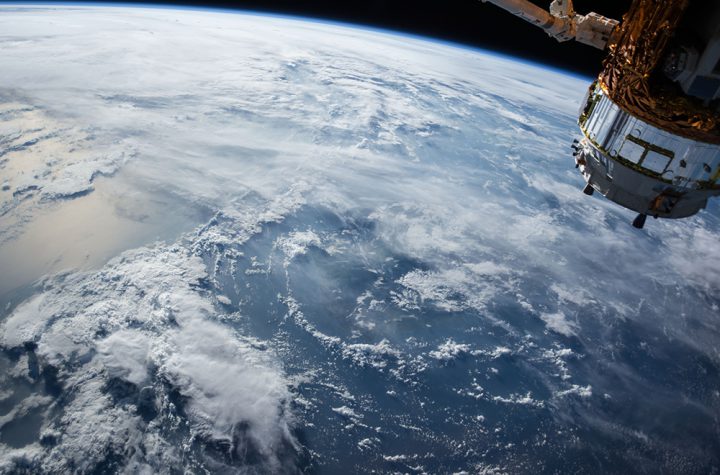
Enlarge/ The cyanobacteria in flasks contribute to the structure at right.
63 with 40 posters participating
It seems like every week, I can do an article on some interesting science that ended up buried under hyperbolic headlines and overly credible coverage. This week’s victim is “living concrete.” It only sort of exists, in that the material can either be living or concrete, but not really both. It doesn’t heal itself either. But none of that means the publication has no merit, as it does show that the concept more or less works, and it identifies a number of areas that need further study in order for “living concrete” to actually become useful.
La vida concrete
The idea of mixing living things and concrete isn’t quite as strange as it sounds. Part of concrete’s strength comes from carbonates that are formed during the curing process. Lots of living things also produce structures made of carbonates; these include some very robust structures that are a mix of proteins and carbonates, like the shells of many aquatic animals.
As such, there’s been a lot of research around the periphery of structural concrete that has involved biology. This has mostly involved lots of work on trying to figure out how the shells of living creatures get some of their impressive properties. But it has also included the idea that living things could form structural carbonates, including a few attempts to make concrete that self-heals thanks to the presence of carbonate-producing microbes embedded in it.
The problem here is that the environment of concrete is not especially compatible with anything staying alive. The initial setting of concrete releases a lot of heat, and the pH remains very high long after the concrete sets. So, all of these attempts have involved finding some way of protecting the “living” portion of things from the “concrete” part.
The new work, done by a team at the University of Colorado in Boulder, avoids the concrete issue entirely. Instead, it tries to make carbonates produced by living things one of the main structural components of their material. It works, but not especially brilliantly.
It’s alive!
The first step the authors focused on was finding the right organism to produce the carbonates. Ideally, they want something that doesn’t need a lot of caresomething they can just set up in their material and ignore for a while. They settled on a species of photosynthetic bacteria called Synechococcus, a type of cyanobacteria. This has the advantage of not needing any special carbon source to produce carbonate, since it gets what it needs by pulling carbon dioxide out of the air. Cyanobacteria also tend to live in aquatic environments, and so many species are adept at pulling what they need to survive out of a sparse environment.
Concrete is typically a mix of a binding material and structural fill. The living concrete was no different. For the fill, the researchers used a cheap material: sand.
This left a major challenge. Forming carbonates is a slow process, so the cyanobacteria wouldn’t be playing any structural role for a while after they are placed in with the sand. So how do you keep the material together long enough for the carbonates to form? The answer they settled on was simple and definitely biologically compatible: gelatin, the material used to make soft, jelly-like foods.
The researchers mixed the gelatin and bacteria and suspended sand in the mixture. This was enough to maintain simple structures for long enough that the cyanobacteria could start forming carbonates.
As long as the mixture was kept at an ambient humidity of 50 percent or more, the gelatin would absorb enough water to maintain a hydrogel that supported bacterial life for at least a week. The metabolic activity of the cyanobacteria could also be adjusted via the temperature: kept at just above freezing, and the bacteria would live longer but wouldn’t deposit much carbonate; heat things up to above room temperature, and there would be more carbonate, but the survival went down.
As long as enough was done to keep some of the bugs alive, the authors showed that you could pull some of the cyanobacteria out of one structure and use them to inoculate a new one. And you could continue that process through at least three generations of structures. (Possibly more, but you’ve got to stop and write the paper at some point.)
So, why isn’t this exciting?
The big problem here is that, as long as the gelatin is kept hydrated, the material is literally held together with jello. The cyanobacteria simply don’t produce enough carbonate within a week to give the “concrete” the sort of material toughness we associate with actual concrete. To do better, you actually have to dry the whole thing out, killing the bacteria in the process. As the gelatin dries out, it forms a mesh of protein mixed with the calcium carbonate formed by the cyanobacteria (which is a mix of calcite and gypsum). This binds the sand together, forming a robust structure.
This is why the material can be living or a concrete, but not both at the same time. This is also why it’s not really a self-healing material. It could self-heal, but only if kept in a floppy, gelatinous state.
A dried gelatin mesh around sand would be a fairly robust material. But the presence of the cyanobacteria improved its resistance to fracture by over 15 percent. It also held up to compression about as well as a low-grade cement, although that was largely down to the sand within the mixture. In any case, the presence of cyanobacteria made the material more robust than gelatin alone. None of these numbers is especially impressive, but it’s entirely possible that the amount of carbonate would continue to go up over time, and the strength of the dried material would go up with it.
In fact, most of this work trails off into a set of possibilities. It might be possible to select the cyanobacteria so that it evolves a greater tolerance to drier conditions, and thus they live longer within the solidifying material. What we could potentially enhance is carbonate production, so that more of the material is produced while the cyanobacteria are alive. We could replace the gelatin with a material that forms a robust mesh while water levels are still high. Of course, all of this is predicated on a large unknown: we don’t know if more carbonate will actually improve the material’s robustness.
All of this makes the paper an intriguing early effort worth some attention. But the researchers really need to think more about how they’re presenting a preliminary study like this. The phrase “living concrete” doesn’t exist anywhere in the paperin fact, the authors state that the new materials “are not intended to broadly replace cementitious materials.” But the phrase is in the title of the press release that launched all those headlines. The researchers do refer to making “living building materials” in the paper, but it’s not clear what, exactly, could be built using the materials in their present state of development.
Matter, 2020. DOI: 10.1016/j.matt.2019.11.016 (About DOIs).





More Stories
The South Australian government has promised to deliver the “biggest hit of economic adrenalin in South Australian history” in Tuesday’s budget.
Boris Johnson will proceed with his controversial Brexit bill despite US president-elect Joe Biden having previously warned the UK over the draft legislation.
Singapore-based Nektar.ai, a productivity platform for sales teams, has raised $2.15 million in seed funding. Founded earlier this year, Nektar has been working in stealth mode with five companies, and has plans for an early adopter release before a public la…